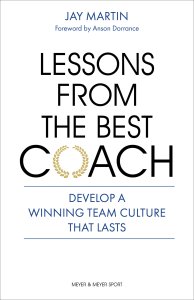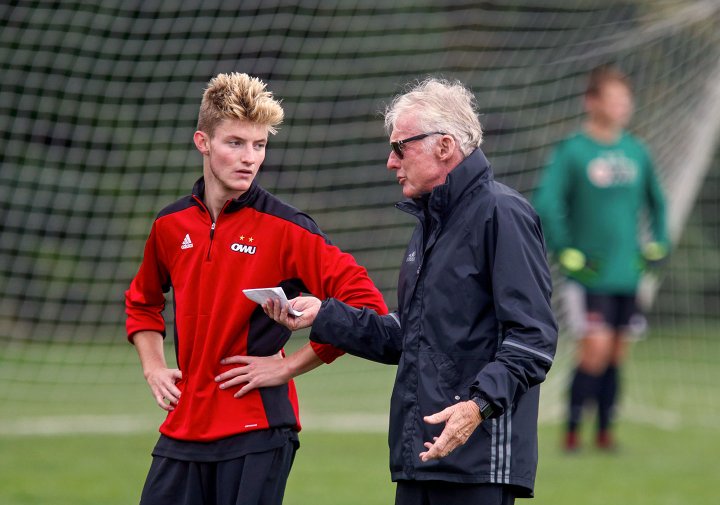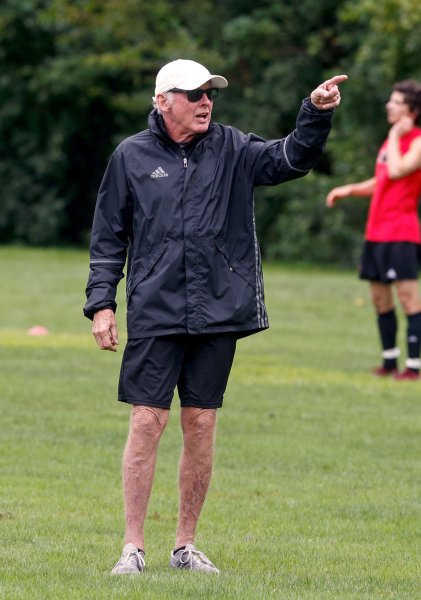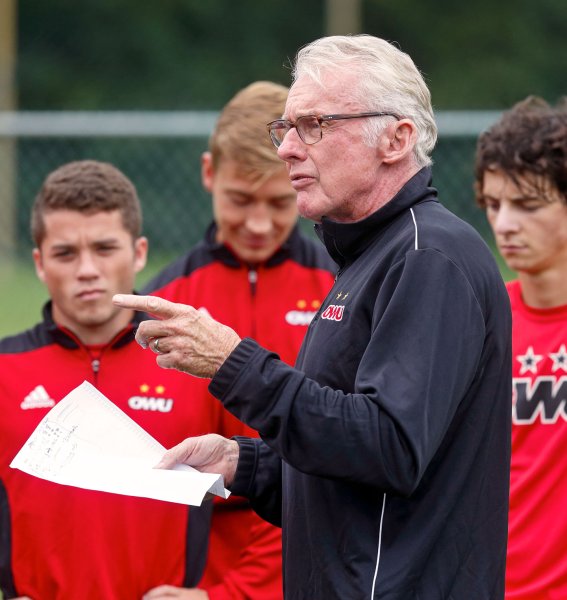Lessons From the Best Coach
In his new book, Lessons from the Best Coach: Develop a Winning Team Culture that Lasts, OWU's legendary Jay Martin explains the management strategy that has made him the most successful coach in NCAA history. Below, OWU Magazine reprints selections from Coach Martin's preface and first chapter.

On Friday, December 2, 2011, the Ohio Wesleyan University men's soccer team was playing in the national Division III semifinal in San Antonio, Texas. The opponent was Montclair State of New Jersey, who won the New Jersey Collegiate Association championship with a 19-2-0 record. In the stands there were 78 former Ohio Wesleyan University players. They knew none of the members on the current team. They were there to support the program. A program they contributed to when they were students at OWU!
They came to San Antonio on their own. They paid their own way down to Texas and took valuable time away from their families during the holiday season.
The OWU team won the game 4-0. On Saturday, an additional 48 former players flew into San Antonio. They were there to support the program. There were even parents of former players in San Antonio!
There were so many former OWU players that there was an impromptu alumni game at Trinity University hosted by the TU coach and good friend Paul McGinlay!
In the final game, OWU defeated a very good Calvin College team 2-1 to win their second national championship. The stands were across the field from the team benches. When the whistle blew, all of the OWU players ran across the field and jumped into the stands to celebrate with the former players. Let me repeat that none of the alumni knew any of the current players, but they knew the program.
As I watched the celebration, my wife, JoAnn, came up to me and said, "Jay, this is what you do, and it has very little to do with soccer! You have connected with these players for the last 35 years. Different players, different generations, the same connection."
I knew that we had a good program. I knew we won a lot of games. But this was a realization: The program was more important than soccer for these players and former players. It made a lasting impact.
This is what this book is about. How can you as a coach or manager or leader create an environment that empowers your players or workers or followers?
The best teams and organizations create an emotional attachment between the players or followers and the organization.
Head Coach, Ohio Wesleyan University Men's Soccer
Coaching or management or leadership is changing. The "my way or the highway" mentality is no longer appropriate. The players or employees today want more. Good coaches/managers or leaders want to create an environment that empowers the players/employees/ followers. They want to create an environment that is positive. They want to create an environment where there is a connection between the coach or manager and the players and followers. The best teams and organizations create an emotional attachment between the players or followers and the organization. I want my players to look at the soccer program as more important than a team.
To me, a soccer team is the two hours each day at practice; a soccer program is the other 22 hours. How many teams have you been on that were two hours each day and not the other 22 hours? My guess is most of them!
Team dynamics suggest that a team goes through four stages. The first stage is the forming stage, the second phase is the storming stage, the third stage is the norming stage, and finally the performing stage. I contend that most teams never get past the storming stage.
This book will lead you and your team or organization through the storming stage and into the performing stage. This book will examine the ways a coach/manager or leader can create an environment that will be embraced by the team members. It will present an environment that is conducive to intrinsic motivation. All good organizations thrive on intrinsic motivation! This book explains how to create a culture. It is a coaching book. Not a soccer coaching book.
Coaching Philosophy

The foundation of my philosophy is very simple, but it makes colleagues and peers shake their head in disbelief.
I do not believe that coaches develop players. You simply cannot make someone else better. Only players can make players better. Most coaches want to believe they make players better. In fact, I know a coach that has on his business card, "…the high school coach who developed (an MLS player)." Sorry, coach, that is not true!
And it is the same in business; managers cannot make employees better—only employees can do that! Coaches and managers don't have this magic wand that they wave over players and employees to make them better! It is not that simple.
Every player who comes to Ohio Wesleyan must change the way he or she plays in order to make the team. This is not a negative thing. Every time players move "up" to a higher level, they must change the way they play. If players continue to play the way they did in high school or club they will not play at Ohio Wesleyan University. And that is the case with most college teams, at least most good college teams.
Players must increase their fitness, play the ball quicker, and increase their strength. That is just a start. That is to get one foot on the practice field. To play and be successful, players must continue to get better. But the coach cannot make the player better! The player must do it!
Every year, we have players who tell me they cannot get better. They say they are "set in their ways." The truth is they don't want to get better, because it is hard. And if they don't get better they don't play!
The best and worst example is from the championship game in San Antonio in 2011. There were four seniors sitting on the bench next to me who did not play! Can you believe that? Senior year! National championship game! But they did not play a minute. It was good that we won easily on Friday in the semi-final. That gave all these players a chance to see some action in the Final Four! But not in the final! They simply did not change the way they played from freshman to senior year.
Convincing players that the coach cannot make them better is difficult. It is hard for a number of reasons, but the biggest reason is our sporting culture in this country. Our system is "coach centric." It must change to be player centric.
American players are reactive, not proactive. Players show up for practice and wait for the coach to tell them what to do. Players then react to what the coach says, and most often, players go through the motions. Players cannot get better doing this. But it is what happens in the United States. We must teach our players and employees the concept of deliberate practice or as Daniel Coyle calls it in The Talent Code, deep practice.
The Importance of Practice

To learn any new skill or gain expertise in a skill you need to practice, practice, and practice some more! No one will debate that. In fact, practice is the only place where players get better. The games are a "test" to see if the players did improve in practice. The players have to take practice seriously.
But it is how you practice that makes the difference. It is the quality of your practice that is more important than the quantity. Practice does not make players perfect; it makes the players' habits permanent. So, highlevel practice makes high-level players. Talent does not make a big difference. Hard work does.
This concept is known as deliberate or deep practice, and it's incredibly powerful.
The common view held, until recently, was that expert-level performance was simply the result of talent and "natural abilities." This view has held back scientific progress towards learning. What really makes experts so talented, from a psychological perspective?
Experts in sport are not people with freakish natural abilities in a particular domain. Experts are experts at maintaining high-levels of practice and improving performance. It's not about what you're born with. It's about how consistently and deliberately you can work to improve your performance.
So, what is deliberate or deep practice? It is a highly structured activity engaged in with the specific goal of improving performance. It requires effort, it has no monetary reward, and it is not inherently or always enjoyable. Deliberate practice takes time to improve performance, but it will improve performance!
There are four steps to deliberate practice. When these conditions are met, practice improves accuracy and speed of performance on cognitive, perceptual, and motor tasks:
- The athlete must be motivated to attend to the task and exert effort to improve performance.
- The design of the task should consider the preexisting knowledge of the athletes so that the task can be correctly understood after a brief period of instruction.
- The coach should provide immediate informative feedback and knowledge of results of your performance.
- The athlete should repeatedly perform the same or similar tasks.
It's important to note that without adequate feedback about performance during practice, efficient learning is impossible and improvement is minimal. How do you, as a coach or manager, provide feedback?
Simple practice isn't enough to rapidly gain skills. Mere repetition of an activity won't lead to improved performance. The practice must be intentional, aimed at improving performance, designed for your current skill level, combined with immediate feedback, and repetitive. The player is responsible for the intentional aspect of practice. The coach is responsible for the immediate feedback!
Becoming an expert is a marathon and not a sprint. You cannot reach peak performance in just a few weeks. Practices must be deliberate and intense.
We start every practice by telling the players what we will do, how we will do it, and (most importantly) why we will do it. Players will be motivated if they know the why! But, in addition, players must come to practice with the goal of getting better. Each player must have his/her own goal for the practice session. The coaching staff has a goal for the team, but real improvement comes from players having their own goal. For example, a soccer player may go to practice with a personal goal of playing two-touch. So, for everything that happens in practice, the player plays two-touch. The player will improve technique and field vision by doing this! The player will get better.
Feedback

In 1974, two Ph.D. candidates in educational psychology—Ronald Gallimore and Roland Tharp— wanted to define the perfect teacher for their doctoral dissertation. They decided to use basketball coach John Wooden as the subject. Coach Wooden still holds the record for the most NCAA tournament championships in basketball.
The researchers watched every practice that season and coded every comment that Coach Wooden used during practice, for example, positive comment, negative comment, business comment, informational comment, etc. When asked which types of comments were used most, most respondents guess "positive comment." After all, we are told repeatedly that positive comments are very valuable for learning and self-esteem! You may be surprised to know that positive feedback was not the most often used. Here is a quick breakdown:
- Positive comments about 6%
- Negative comments about 6%
- Informational comments about 74%
To improve, athletes need information, not just positive reinforcement. A few years ago, I observed an academy session of an MLS club. The session lasted one hour and 15 minutes. The session focused on the near post/far attacking part of the game.
During the entire session, the coaches did not offer one piece of information! They offered many positive comments, but no information. The runs were wrong, the serves were wrong, the defenders were wrong. The exercise was a disaster. Yet the players left feeling that they got better at attacking the goals. They did not get better. They may have even gotten worse!
Doug Lemov in his book, Practice Perfect, offers some tips on the use of feedback in a practice setting:
- Practice using feedback. The coach must create an environment where feedback is used as quickly as possible. For example, in an activity where there is a line, after giving feedback, put the player back at the top of the line and not the back of the line. Have the player repeat the task immediately. Use feedback immediately!
- Apply feedback first and then reflect on feedback. Ask players to apply feedback before thinking about it. That will help the player make using feedback a habit.
- Shorten the feedback loop. John Wooden thought that correction was wasted unless done immediately!
- Use the power of positive. What players do right in practice is as important as what they do wrong. Catch them doing something right!
- Limit yourself. Limit yourself in the amount of feedback you give; people can only focus on a few things at a time.
- Make it an everyday thing. Consistent feedback in practice makes it a normal part of the learning process. Start giving feedback immediately in the first practice; don't wait for something negative to happen!
- Describe the solution, not the problem. Move away from using the words "don't" and "but." Tell players how they can succeed. Research suggests that one of the most demotivating aspects of sport is that coaches criticize but do not correct or provide information!
- Lock it in. Make sure that the player interprets the feedback correctly by asking the player to summarize what was said; ask players to prioritize the feedback and ask how they will implement feedback.
